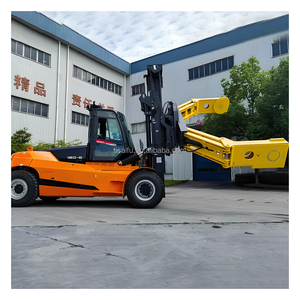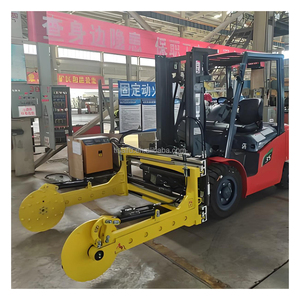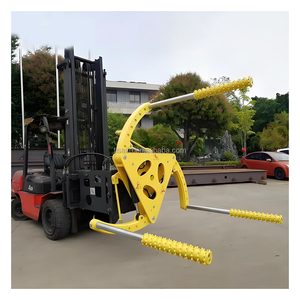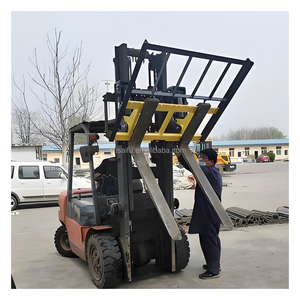
All categories
Featured selections
Trade Assurance
Buyer Central
Help Center
Get the app
Become a supplier

(987 products available)










































The single double pallet handler forklift attachment is vital to the material handling industry. The most known types are elaborated on below.
The single-double pallet handler is one of the most common forklift attachments for handling pallets. This device allows moving one pallet at a time from a stack of pallets, which makes it easier to operate in narrow aisle systems and bulk storage. Unlike other handlers, the single-double design is lightweight and doesn't require an increase of the forklift's hydraulic system. This handler is an economical choice for businesses' medium and low capacities.
This type of handler has two forks mounted on a scissor mechanism, allowing them to operate at different heights. It is useful for both single and double pallet operations. The advantage of a scissor-type handler is that it can stack pallets more efficiently than a standard double handler, providing more versatility in warehousing with vertical storage needs.
The standard double pallet handler is designed to lift two pallets simultaneously. It efficiently carries heavy loads, especially in large warehouse operations. Unlike the single-double handler, the standard type is not able to stack pallets and thus is suitable where the need is only for transport without stacking or complex management of the pallets.
Chain drive double handlers are specialized attachments that use a chain drive mechanism to control the movement of the outer forks. This design provides higher durability and is useful in heavy-duty applications. The chain drive system is favorable in operations with large and heavy pallets to be moved around, as it results in a handler that can withstand more stress and wear than other types.
Double pallet handlers are popular tools that are frequently used in warehouses and material handling due to their flexibility and efficiency.
In warehouses, forklifts with double pallet handlers are widely used. Materials can be transported faster from one area to another, resulting in better utilization of storage abilities. This attachment is especially useful for cross-docking operations where items are routinely moved from one pallet to another without the need for unloading them from the forklift.
These handlers are also used in manufacturing plants to guarantee a steady supply of materials. This is done while reducing the number of trips made by forklifts to enhance productivity. In such facilities, bulk handling ability and swift transportation of materials are crucial to maintaining production flow.
Distribution centers capitalize on the efficiency of the forklift double pallet handler attachment. These centers frequently deal with large volumes of pallets, and the ability to transport two at a time significantly increases throughput. In these fast-paced environments, the handlers are crucial in ensuring swift operations and accurate deliveries.
Large retail outlets with stocking warehouses also utilize double pallet handlers. They manage large shipments of goods arriving in pallets, which they transport to the sales floor. These handlers are very useful when dealing with bulky and heavy products, which need to be moved quickly and efficiently.
Cold storage facilities use double pallet handlers due to their effectiveness in maximizing space utilization. These handlers provide storage capabilities for perishables. This is especially important in the food and pharmaceutical industries, where quick inventory management is necessary to maintain the integrity of goods.
Double pallet handlers are important tools within several industrial settings. Knowing their specifications and features enables one to appreciate their workings.
Some of the features of the double pallet handler include the following:
Twin forks
The main feature of the double pallet handler is the presence of twin forks. One pallet is carried on each fork by these extra-long forks. This construction allows the handler to lift and transport two pallets concurrently. This capability is valuable when working with large loads or in situations where efficiency is paramount.
Side Shift Mechanism
A side shift allows shifting the forks slightly to either side. This is good for positioning pallets precisely during loading and unloading. Most double pallet handlers have a side shift mechanism integrated into the design. It is very useful when working in limited spaces or when the pallets are stacked closely together.
Fork spacing adjustment
This feature permits adjustment of the spacing between the two forks. This makes it possible to handle pallets of varied sizes. Flexibility in handling different pallet dimensions is beneficial to operations that deal with diverse products requiring different pallet constructions.
Pallet anti-collision system
Since this handler is meant to handle two pallets at a time, a system that counterchecks collisions between the two pallets is installed to improve safety. The system reduces impact chances, protecting the cargo from damage during transport.
Heavy-duty construction
The pallet jack double triple handler is built with tough materials for durability given the demands of industrial work. The forks, frames, and hydraulic components are all reinforced to endure heavy loads. Quality construction ensures reliability and longevity and decreases the need for frequent maintenance.
Double pallet handlers are compatible with particular types and sizes of forklifts. The handler's hydraulic requirements should be considered to ensure proper functioning. Also, compatibility with various forklift models ensures average performance without the need to modify existing equipment.
Below are the steps to install a pallet handler:
Preparing the forklift
Before installing the handler, the appropriate forklift power source must be selected. Preparation entails clearing the front attachment section and ensuring the handler fits correctly without modifications.
Mounting the handler
The handler should then be positioned on the forklift. The mounting brackets can then be attached to secure the handler to the forklift. This requires aligning the handler with the mounting points and then bolting them together. For hydraulic components, the handler's hydraulic lines should be connected to the forklift's hydraulic systems. This enables the handlers' functionalities, such as lifting and tilting.
Testing
Complete installation is followed by testing the handler. The handler should be checked for operational effectiveness by lifting empty and light pallet loads. All movements should be smooth, including lifting, lowering, tilting, and fork spacing. Any needed adjustments are made at this point to ensure safety and proper functioning.
Maintenance and repairs prolong the lifespan of the handler. Here is how to do it:
Regular inspections
A regular exam is done on the handler to determine its working condition. Checks focus on wear and tear parts like hydraulic cylinders, forks, and frames. The handler is taken out of service to rectify any acquired damage and to perform repairs. This prevents further degradation and maintains safety standards.
Lubrication
Proper handler service involves frequent handler lubrication. Continuous oiling of moving parts like joints, bearings, and slide rails minimizes friction, which in turn increases the handler's efficiency. Lubrication is to be done using the right type of lubricant as prescribed in the manufacturer's guidelines. This reduces handler wear and enhances lifespan.
Hydraulic system maintenance
The handler's lifting capacity and functionality depend on the hydraulic system. Maintenance entails frequent checks on hydraulic fluid levels and signs of leaking around the cylinders. It is recommended that the hydraulic system undergo fluid replacement and filter change after some time according to the manufacturer's recommendations. A healthy hydraulic system is essential for reliable operation.
Fork and frame check
The fork and frame of the handler are to be examined for cracks, bends, or warping due to continuous usage. Any signs of damage should be rectified immediately as they may pose safety hazards and interfere with operating capacity. Weak forks or bent frames can bring about unpredictable load handling, hence, lower productivity or even risk accidents.
Professional repair
Complex repairs, such as those involving the hydraulic system or structural welding, should be undertaken by a qualified professional. It is always advisable to consult a professional service provider as they utilize genuine manufacturer parts. This ensures repair maintenance does not degrade the handler's functionality.
The handler should be of good quality for it to be functional and efficient. Safety and quality are very vital for handlers in industrial settings. Below are some of them:
Safety should be prioritized by investing in handlers from reputable manufacturers who adhere to international quality standards. Proper certifications are available, for instance, ISO or CE. Quality checks on materials are done before the purchase to ensure the handler is manufactured with high-strength steel. This promotes durability. Forks, frames, and hydraulic components are reinforced for heavy loads. This minimizes risks of failure and increases the lifespan of the handler.
This handler is designed to handle a specific load capacity. Loads beyond capacity may put the handler at risk of failing or bending. It is important to confirm that the forklift and handler combined have the required capacity to handle the load of a pallet.
Operators should be given proper training on using double pallet handlers. They should also be aware of the limitations of both the forklift and the attachment. Handlers can be difficult to control when carrying two pallets, which calls for skilled operators to manage the load effectively. Informing operators about safety measures eliminates accidents.
Avoid using a handler that has not been maintained, as this could mean it has defects or it is in bad condition. Daily checks on the handler are critical before use - looking for signs of wear, tear, and leakage within hydraulic systems. The maintenance schedule as per the manufacturer's guidelines should be followed to avoid handler failure. It also ensures reliability is heightened, and potential problems are averted.
Emergency procedures must always be considered when operating machines in any setting to reduce risk in cases of problems arising. Knowing the stop rules and the time required to release the handler from heavy lifts is important. This prevents accidents and damage to equipment or materials.
A1: Determine the maximum load and pallet size that will be handled and the forklifts' capability and compatibility.
A2: Only scissor-type double handlers can stack pallets. The others are meant for transporting only.
A3:The handler should be lubricated often, preferably daily, before the start of work.
A4: Yes. Training is crucial for safety and efficiency within the operating area.
A5: It facilitates precise pallet placement, improving efficiency in loading and unloading.